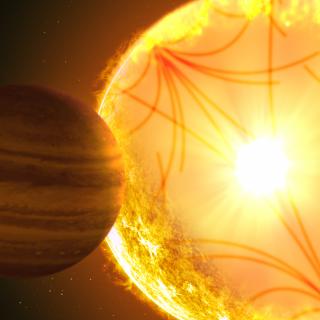Bibcode
Deeg, H. J.; Alonso, R.
Referencia bibliográfica
Contributions of the Astronomical Observatory Skalnate Pleso
Fecha de publicación:
2
2024
Número de citas
0
Número de citas referidas
0
Descripción
Detections of transiting planets from the upcoming PLATO mission are expected to face significant contamination from contaminating eclipsing binaries, resulting in false positives. To counter this, a ground-based programme to acquire time-critical photometry is pursued. Its principal aim is to obtain time-series observations of the planet candidate and its surrounding stars at the times of expected transits. This programme is part of the PLATO Ground-based Observations Programme, which also covers spectroscopic and imaging observations. The current photometric follow-up programme is assembling the required observational resources, executing benchmark observations, and defining strategies for the observations and their reporting. Post-launch, it will focus on coordinating photometric data collection and analysis, and will update candidate statuses in the PLATO follow-up database. Its work packages are outlined, covering specific tools, citizen contributions, standard and multi-colour observations, secondary eclipses, and reprocessing of archival photometry. Ground-based follow-up photometry will likely concentrate on longer-period candidates, given that false positives of short-period candidates will likely become identifiable in timeseries available from GAIA in the near future. Geographical considerations for follow-up observations from the first PLATO long-observation field LOPS2 are outlined, which lies in the southern hemisphere, with later fields expected to be more suitable for northern observers.
Proyectos relacionados

Sismología Solar y Estelar y Búsqueda de Exoplanetas
Los objetivos genéricos de este Proyecto son: 1) el estudio de la estructura y dinámica del interior solar, 2) la extensión de dicho estudio al caso de otras estrellas, 3) la búsqueda y caracterización de planetas extrasolares por métodos fotométricos (principalmente mediante el método de tránsitos) y espectroscópico (variaciones en la velocidad
Savita
Mathur

Exoplanetas y Astrobiología
La búsqueda de vida en el Universo se ha visto impulsada por los recientes descubrimientos de planetas alrededor de otras estrellas (los llamados exoplanetas), convirtiéndose en uno de los campos más activos dentro de la Astrofísica moderna. En los últimos años los descubrimientos cada vez más numerosos de nuevos exoplanetas y los últimos avances
Enric
Pallé Bago